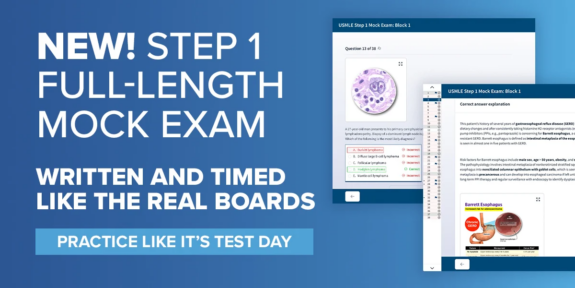The USMLEs (United States Medical Licensing Examinations) are a series of exams (referred to as “Steps”) that assess an aspiring physician’s ability to demonstrate fundamental medical knowledge by answering difficult multiple choice questions.
For international medical graduates (IMGs) planning to practice medicine in the United States, passing and scoring well on these exams is crucial. Understanding how to prepare along with a strong performance on Step 1 lays a solid foundation for future USMLE Step exams, and provides a benchmark to compare IMGs with US medical graduates.
Each Step exam is difficult in its own right, and there are various reasons you may need to retake it. This guide offers detailed advice for how to retake Step 1 as an IMG, focusing on preparation, the retake process, and the potential impact on your residency application if you don’t pass the first time.

Preparing for USMLE Step 1 as an IMG? We’re here to help! Take a Step 1 mock exam to simulate exactly what test day will be like, and get a score report to help you understand what you need to work in on order to pass.
Why are Step 1 pass rates lower for IMGs?
In 2023, examinees from US/Canadian Schools had a 90% Step 1 pass rate, whereas examinees from non-US/Canadian schools had a 68% pass rate according to the USMLE.
While it varies year to year, IMGs do typically have a lower pass rate for USMLE exams due to a combination of educational, logistical, and systemic challenges. Firstly, the medical curricula in many countries differ significantly from the US system, both in content and structure.
While US medical students typically follow a standardized curriculum designed to align closely with USMLE exam content, IMGs may not have covered certain topics in the same depth or sequence. This discrepancy can leave IMGs underprepared for the specific types of questions and the focus areas emphasized on USMLE Step 1.
Additionally, IMGs often face logistical and resource-related challenges. Access to high-quality preparatory materials, review courses, and practice exams, which are widely available and often integrated into the US medical education system, may be limited or prohibitively expensive for IMGs. Language barriers can also play a significant role. But even if IMGs are proficient in English, the nuanced medical terminology, high-pressure, and timed exam environment can add an extra layer of difficulty.
These educational and logistical hurdles are compounded by systemic factors, such as the need for IMGs to navigate complex credentialing processes and visa regulations, which can add considerable stress and distraction. Unlike their US counterparts, who generally take the USMLE exams at specific, structured points in their training, IMGs often need to prepare for these exams while simultaneously managing other significant transitional challenges.
How do I retake Step 1 as an IMG?
Step 1 Retake Policy
Examinees can retake USMLE Step 1 if they failed on the initial attempt. Retaking is not allowed once you pass, except to comply with certain state board requirements which have been previously approved by USMLE governance. There is no sense in retaking it anyways if you passed on the initial attempt, since Step 1 is not scored. The other reason to retake is if your exam is invalidated (in the event of software failure, computer issues, or other major interruptions during the test).
If you fail Step 1 (or any USMLE Step exam), you can retake it after reapplying and paying for the registration and scheduling fees. Similar to registering for Step 1 the first time, for the retake you’ll be given a scheduling token after you select an eligibility period. Study, select a date/location, and then sit for the exam.
Number of Attempts Allowed
The USMLE affords an examinee four chances to pass the same exam. Examinees who have attempted a Step four or more times (including incomplete attempts) and have not passed are ineligible to apply for any Step in the USMLE exam sequence. All attempts at a Step are counted toward the limit, regardless of when the exams were taken. This is straight from the website, where you can find more info.
Timing & Rules
Examinees may not take the same Step exam more than three times in a 12-month period. Your fourth attempt must be at least 12 months after your first attempt and at least six months after your most recent attempt at that exam. Be aware of the timing when selecting your eligibility period.
In order to be licensed, examinees must pass all the Step exams within seven years of first passing any Step of the USMLE. You must pass Step 1 and Step 2 before you’re eligible to take Step 3.
Students and graduates of medical schools outside the United States and Canada should contact the ECFMG for information on ECFMG certification and Step 1 and Step 2 eligibility.
How do I prepare to retake Step 1 as an IMG?
If you don’t pass Step 1 the first time, it’s not the end of the world. You can still do it! For IMGs that have to retake the exam, I recommend the following.
Find more exam prep tips for IMGs in this other blog post, Our Top USMLE Tips & Tricks for IMGs Applying to US Residencies!
1. Analyze your performance.
Start by thoroughly reviewing your score report to identify areas where you need improvement. Look for patterns in your mistakes, whether they are content-specific, related to question types, or due to time management issues. Focus on the high-yield topics that you missed AND are heavily weighted in the exam.
For instance, if you scored low in BOTH respiratory and renal pathology as well as the biochemistry of musculoskeletal, skin, and subcutaneous tissue, the focus should be on renal and respiratory as that section is weighted higher, meaning you’ll have to answer more questions on the topic for Step 1.
2. Create a new study plan.
Perhaps your Step 1 study plan the first time around needs some improvement—or maybe you didn’t use a study plan the first time around. Either way, develop a comprehensive study plan that focuses on your weak areas while also reinforcing your strengths, incorporating breaks and time for wellness.
Allocate specific times for different subjects, and incorporate regular review sessions, while also leaving time for practice exams. It’ll be important to stick to your study plan/schedule and follow it.
3. Check your resources.
Good preparation requires hard work along with the proper study resources. Make sure to incorporate study material as well as question banks and timed practice exams. You need to learn the material and apply your knowledge on extensive question databases that mimic the format and difficulty of the actual exam in a timed manner. Then review it all to further improve.
Joining study groups or online forums can provide motivation, support, and different perspectives on challenging topics. Talking with peers can also help clarify difficult concepts.
Lastly, taking regular Step 1 practice exams is essential to build stamina and familiarity with the test format. Use NBME self-assessment forms to gauge your progress and readiness and see how you perform under pressure.
Final Thoughts
IMGs retaking Step 1 need introspection, careful planning, and hard work to be successful the second time around. While having to retake the exam presents challenges, it also offers opportunities to demonstrate resilience and improvement, which are valuable traits in the eyes of a residency program director.
By preparing effectively and understanding the implications of retaking the exam, you can navigate this process successfully and enhance your chances of securing a residency position in the US. Good luck next time on Step 1, and please reach out if you need any assistance.





